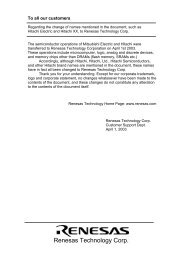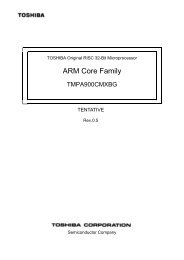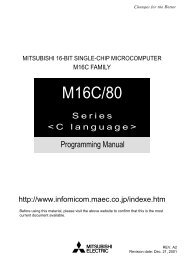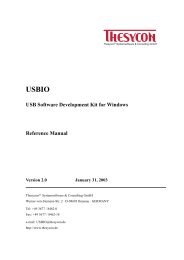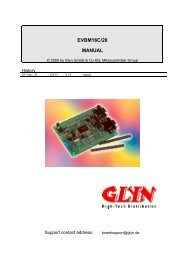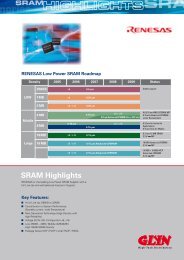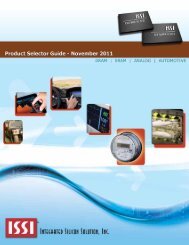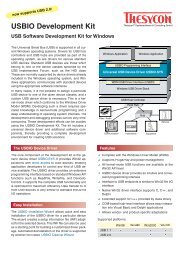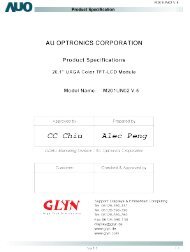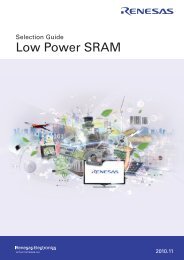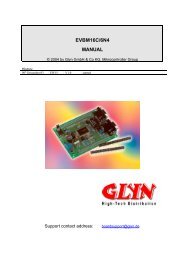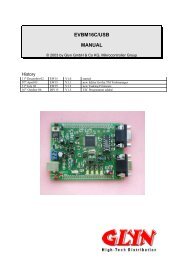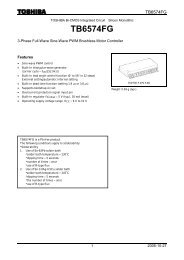Datasheet Toshiba - TLP185(GB,E)
Datasheet Toshiba - TLP185(GB,E)
Datasheet Toshiba - TLP185(GB,E)
Create successful ePaper yourself
Turn your PDF publications into a flip-book with our unique Google optimized e-Paper software.
Office Machine<br />
Programmable Controllers<br />
AC Adapter<br />
I/O Interface Board<br />
TOSHIBA Photocoupler GaAs Ired & Photo−Transistor<br />
<strong>TLP185</strong><br />
The TOSHIBA mini flat coupler <strong>TLP185</strong> is a small outline coupler, suitable<br />
for surface mount assembly.<br />
<strong>TLP185</strong> consist of a photo transistor optically coupled to a gallium arsenide<br />
infrared emitting diode. Since <strong>TLP185</strong> is smaller than DIP package, it’s<br />
suitable for high-density surface mounting applications such as<br />
programmable controllers<br />
• Collector−emitter voltage: 80V (min)<br />
• Current transfer ratio: 50% (min)<br />
Rank <strong>GB</strong>: 100% (min)<br />
• Isolation voltage: 3750Vrms (min)<br />
• Operation Temperature:-55 to 110 ˚C<br />
• Safety Standards<br />
UL approved: UL1577, File No. E67349<br />
cUL approved: CSA Component Acceptance Service No. 5A<br />
File No.E67349<br />
• BSI approved: BS EN60065:2002, Certificate No. 9020<br />
BS EN60950-1:2006, Certificate No. 9021<br />
• Option (V4) type<br />
VDE approved: EN60747-5-2, Certificate No. 40009347<br />
(Note): When a EN60747-5-2 approved type is needed,<br />
Please designate “Option(V4)”<br />
• Construction mechanical rating<br />
Creepage distance : 5.0 mm(min)<br />
Clearance : 5.0 mm(min)<br />
Insulation thickness : 0.4 mm(min)<br />
1<br />
TOSHIBA 11-4M1S<br />
Weight: 0.08 g (Typ.)<br />
1<br />
3<br />
1: Anode<br />
3: Cathode<br />
4: Emitter<br />
6: Collector<br />
<strong>TLP185</strong><br />
6<br />
4<br />
Unit: mm<br />
Pin Configuration(top view)<br />
2012-02-14
Current Transfer Ratio<br />
Type<br />
<strong>TLP185</strong><br />
Classification<br />
Note1<br />
Current Transfer Ratio (%)<br />
(IC / IF)<br />
IF = 5mA, VCE = 5V, Ta = 25°C<br />
Min Max<br />
2<br />
Marking Of Classification<br />
Blank 50 400 Blank, YE, GR, <strong>GB</strong>, Y+, G, G+, B<br />
Rank Y 50 150 YE<br />
Rank GR 100 300 GR<br />
Rank <strong>GB</strong> 100 400 <strong>GB</strong><br />
Rank YH 75 150 Y+<br />
Rank GRL 100 200 G<br />
Rank GRH 150 300 G+<br />
Rank BLL 200 400 B<br />
(Note1): Ex Rank <strong>GB</strong>: <strong>TLP185</strong> (<strong>GB</strong>,E<br />
(Note) Application, type name for certification test, please use standard product type name, i, e.<br />
<strong>TLP185</strong>(<strong>GB</strong>,E: <strong>TLP185</strong><br />
<strong>TLP185</strong><br />
2012-02-14
Absolute Maximum Ratings (Ta = 25°C)<br />
LED<br />
Detector<br />
3<br />
<strong>TLP185</strong><br />
Note: Using continuously under heavy loads (e.g. the application of high temperature/current/voltage and the<br />
significant change in temperature, etc.) may cause this product to decrease in the reliability significantly even<br />
if the operating conditions (i.e. operating temperature/current/voltage, etc.) are within the absolute maximum<br />
ratings.<br />
Please design the appropriate reliability upon reviewing the <strong>Toshiba</strong> Semiconductor Reliability Handbook<br />
(“Handling Precautions”/“Derating Concept and Methods”) and individual reliability data (i.e. reliability test<br />
report and estimated failure rate, etc).<br />
Note 2: Pulse width ≤ 100 μs,f=100 Hz<br />
Characteristic Symbol Rating Unit<br />
Forward current IF 50 mA<br />
Forward current derating (Ta ≥ 90°C) ΔIF / °C -1.5 mA / °C<br />
Pulse forward current (Note2) IFP 1 A<br />
Reverse voltage VR 5 V<br />
Junction temperature Tj 125 °C<br />
Collector−emitter voltage VCEO 80 V<br />
Emitter−collector voltage VECO 7 V<br />
Collector current IC 50 mA<br />
Collector power dissipation PC 150 mW<br />
Collector power dissipation derating (Ta ≥ 25°C) ΔPC / °C -1.5 mW / °C<br />
Junction temperature Tj 125 °C<br />
Operating temperature range Topr −55 to 110 °C<br />
Storage temperature range Tstg −55 to 125 °C<br />
Lead soldering temperature Tsol 260 (10s) °C<br />
Total package power dissipation PT 200 mW<br />
Total package power dissipation derating (Ta ≥ 25°C) ΔPT / °C -2.0 mW / °C<br />
Isolation voltage (AC, 1min., R.H. ≤ 60%) (Note 3) BVS 3750 Vrms<br />
Note 3: Device considered a two terminal device: Pins 1 and 3 shorted together and 4 and 6 shorted together.<br />
Recommended Operating Conditions (Note)<br />
Characteristic Symbol Min. Typ. Max. Unit<br />
Supply voltage VCC ― 5 48 V<br />
Forward current IF ― 16 20 mA<br />
Collector current IC ― 1 10 mA<br />
Note: Recommended operating conditions are given as a design guideline to obtain expected performance of the<br />
device. Additionally, each item is an independent guideline respectively. In developing designs using this<br />
product, please confirm specified characteristics shown in this document.<br />
2012-02-14
Individual Electrical Characteristics (Ta = 25°C)<br />
LED<br />
Detector<br />
4<br />
<strong>TLP185</strong><br />
Characteristic Symbol Test Condition Min Typ. Max Unit<br />
Forward voltage VF IF = 10 mA 1.1 1.25 1.4 V<br />
Reverse current IR VR = 5 V — — 5 μA<br />
Capacitance CT V = 0, f = 1 MHz — 30 — pF<br />
Collector−emitter<br />
breakdown voltage<br />
Emitter−collector<br />
breakdown voltage<br />
Collector dark current ICEO<br />
Capacitance<br />
(collector to emitter)<br />
Coupled Electrical Characteristics (Ta = 25°C)<br />
V(BR) CEO IC = 0.5 mA 80 — — V<br />
V(BR) ECO IE = 0.1 mA 7 — — V<br />
VCE = 48 V — 0.01 0.08 μA<br />
VCE = 48 V, Ta = 85°C — 2 50 μA<br />
CCE V = 0, f = 1 MHz — 10 — pF<br />
Characteristic Symbol Test Condition MIn Typ. Max Unit<br />
Current transfer ratio IC / IF<br />
Saturated CTR IC / IF (sat)<br />
Collector−emitter<br />
saturation voltage<br />
IF = 5 mA, VCE = 5 V<br />
Rank <strong>GB</strong><br />
IF = 1 mA, VCE = 0.4 V<br />
Rank <strong>GB</strong><br />
50 — 400<br />
100 — 400<br />
— 60 —<br />
30 — —<br />
IC = 2.4 mA, IF = 8 mA — — 0.3<br />
VCE (sat) IC = 0.2 mA, IF = 1 mA<br />
Rank <strong>GB</strong><br />
— 0.2 —<br />
— — 0.3<br />
Off−state collector current IC (off) VF = 0.7V, VCE = 48 V — 1 10 μA<br />
Isolation Characteristics (Ta = 25°C)<br />
Capacitance<br />
(input to output)<br />
Characteristic Symbol Test Condition Min Typ. Max Unit<br />
CS VS = 0V, f = 1 MHz — 0.8 — pF<br />
Isolation resistance RS VS = 500 V, R.H. ≤ 60% 1×10 12<br />
Isolation voltage BVS<br />
10 14<br />
AC, 1 minute 3750 — —<br />
AC, 1 second, in oil — 10000 —<br />
%<br />
%<br />
V<br />
— Ω<br />
Vrms<br />
DC, 1 minute, in oil — 10000 — Vdc<br />
2012-02-14
Switching Characteristics (Ta = 25°C)<br />
5<br />
<strong>TLP185</strong><br />
Characteristic Symbol Test Condition Min Typ. Max Unit<br />
Rise time tr — 5 —<br />
Fall time tf VCC = 10 V, IC = 2 mA<br />
— 9 —<br />
RL = 100Ω<br />
Turn−on time ton — 9 —<br />
Turn−off time toff<br />
— 9 —<br />
Turn−on time ton — 2 —<br />
Storage time ts<br />
RL = 1.9 kΩ<br />
VCC = 5 V, IF = 16 mA<br />
(Fig.1)<br />
— 30 —<br />
Turn−off time toff<br />
— 70 —<br />
Fig. 1 Switching time test circuit<br />
IF VCC<br />
RL<br />
VCE<br />
IF<br />
VCE<br />
ton<br />
tON<br />
tS<br />
toff<br />
tOFF<br />
VCC<br />
4.5V<br />
0.5V<br />
μs<br />
μs<br />
2012-02-14
Forward current I F (mA)<br />
Pulse forward current IFP (mA)<br />
Forward voltage temperature coefficient<br />
ΔVF /ΔTa (mV/°C)<br />
3000<br />
1000<br />
500<br />
300<br />
100<br />
50<br />
30<br />
10<br />
-3.2<br />
-2.8<br />
-2.4<br />
-2<br />
-1.6<br />
-1.2<br />
100<br />
80<br />
60<br />
40<br />
20<br />
I F -Ta<br />
This curve shows the maximum<br />
limit to the forward current.<br />
0<br />
-20 0 20 40 60 80 100 120<br />
6<br />
Collector power dissipation PC (mW)<br />
160<br />
140<br />
120<br />
100<br />
80<br />
60<br />
40<br />
20<br />
P C -Ta<br />
<strong>TLP185</strong><br />
0<br />
-20 0 20 40 60 80 100 120<br />
Ambient temperature Ta (˚C) Ambient temperature Ta (˚C)<br />
I FP-DR I F -VF<br />
Pulse width≤100μs<br />
Ta=25˚C<br />
This curve shows the maximum<br />
limit to the pulse forward current.<br />
10 -3 10 -2<br />
10 -1 10 0<br />
Forward current IF (mA)<br />
100<br />
10<br />
1<br />
0.1<br />
0.6 0.8 1 1.2 1.4 1.6 1.8 2<br />
Duty cycle ratio DR Forward voltage VF (V)<br />
∆ V F / ∆ Ta-I F I FP – VFP 1000<br />
-0.8<br />
Pulse width≤10μs<br />
Repetitive frequency=100Hz<br />
-0.4<br />
Ta=25°C<br />
0.1 1 10 100<br />
1<br />
0.6 1 1.4 1.8 2.2 2.6 3 3.4<br />
Forward current IF (mA) Pulse forward voltage VFP (V)<br />
*The above graphs show typical characteristic.<br />
Pulse forward current IFP (mA)<br />
100<br />
10<br />
This curve shows the<br />
maximum limit to the<br />
collector power dissipation.<br />
110˚C<br />
85˚C<br />
50˚C<br />
25˚C<br />
0˚C<br />
-25˚C<br />
-55˚C<br />
2012-02-14
Collector current IC (mA)<br />
Collector current IC (mA)<br />
Current transfer ratio IC / IF (%)<br />
50<br />
40<br />
30<br />
20<br />
10<br />
I C -V CE<br />
0<br />
0 2 4 6 8 10<br />
7<br />
Collector current IC (mA)<br />
30<br />
20<br />
10<br />
I C -V CE<br />
<strong>TLP185</strong><br />
0<br />
0 0.2 0.4 0.6 0.8 1<br />
Collector-emitter voltage VCE (V) Collector-emitter voltage VCE (V)<br />
100<br />
10<br />
1<br />
I C -IF ICEO-Ta<br />
VCE<br />
0.1<br />
0.1 1 10 100<br />
=10V<br />
VCE =5V<br />
VCE =0.4V<br />
1000<br />
100<br />
Ta=25˚C<br />
P C (max)<br />
50<br />
30<br />
20<br />
Collector dark current ID (ICEO) (μA)<br />
10<br />
1<br />
0.1<br />
0.01<br />
0.001<br />
0.0001<br />
0 20 40 60 80 100 120<br />
Forward current IF (mA) Ambient temperature Ta (°C)<br />
VCE =10V<br />
VCE =5V<br />
VCE=0.4V<br />
I C/ I F -I F<br />
10<br />
0.1 1 10 100<br />
Forward current IF (mA)<br />
*The above graphs show typical characteristic.<br />
15<br />
Ta=25˚C<br />
10<br />
I F =5mA<br />
Ta=25˚C<br />
VCE=48V<br />
24V<br />
10V<br />
5V<br />
50<br />
30<br />
20<br />
15<br />
10<br />
5<br />
I F= 2mA<br />
2012-02-14
Collector-Emitter saturation<br />
Voltage VCE(sat) (V)<br />
Switching time (μs)<br />
0.28<br />
0.24<br />
0.20<br />
0.16<br />
0.12<br />
0.08<br />
0.04<br />
V CE(sat) - Ta I C - Ta<br />
0.00<br />
-60 -40 -20 0 20 40 60 80 100 120<br />
10000<br />
1000<br />
100<br />
10<br />
1<br />
Ambient temperature Ta (°C)<br />
8<br />
Collector current IC (mA)<br />
100<br />
10<br />
1<br />
<strong>TLP185</strong><br />
0.1<br />
-60 -40 -20 0 20 40 60 80 100 120<br />
Ambient temperature Ta (°C)<br />
Switching time - R L Switching time - Ta<br />
Ta=25˚C<br />
IF=16mA<br />
VCC=5V<br />
t off<br />
IF=8mA, IC=2.4mA<br />
IF=1mA, IC=0.2mA<br />
1 10 100<br />
Switching time (μs)<br />
1000<br />
100<br />
10<br />
1<br />
IF=16mA<br />
VCC=5V<br />
RL=1.9kΩ<br />
0.1<br />
-60 -40 -20 0 20 40 60 80 100 120<br />
Load resistance RL (kΩ) Ambient temperature Ta (°C)<br />
*The above graphs show typical characteristic.<br />
t s<br />
t on<br />
VCE=5V<br />
25<br />
10<br />
5<br />
1<br />
IF=0.5mA<br />
t off<br />
t s<br />
t off<br />
2012-02-14
Soldering and Storage<br />
1. Soldering<br />
1.1 Soldering<br />
9<br />
<strong>TLP185</strong><br />
When using a soldering iron or medium infrared ray/hot air reflow, avoid a rise in device temperature as<br />
much as possible by observing the following conditions.<br />
1) Using solder reflow<br />
·Temperature profile example of lead (Pb) solder<br />
(°C)<br />
240<br />
Package surface temperature<br />
·Temperature profile example of using lead (Pb)-free solder<br />
Package surface temperature<br />
210<br />
160<br />
140<br />
(°C)<br />
260<br />
230<br />
190<br />
180<br />
2) Using solder flow (for lead (Pb) solder, or lead (Pb)-free solder)<br />
Please preheat it at 150°C between 60 and 120 seconds.<br />
Complete soldering within 10 seconds below 260°C. Each pin may be heated at most once.<br />
3) Using a soldering iron<br />
60 to 120s less than 30s<br />
60 to 120s<br />
Complete soldering within 10 seconds below 260°C, or within 3 seconds at 350°C. Each pin<br />
may be heated at most once.<br />
Time (s)<br />
30 to 50s<br />
Time (s)<br />
This profile is based on the device’s<br />
maximum heat resistance guaranteed<br />
value.<br />
Set the preheat temperature/heating<br />
temperature to the optimum temperature<br />
corresponding to the solder paste<br />
type used by the customer within the<br />
described profile.<br />
This profile is based on the device’s<br />
maximum heat resistance guaranteed<br />
value.<br />
Set the preheat temperature/heating<br />
temperature to the optimum temperature<br />
corresponding to the solder paste<br />
type used by the customer within the<br />
described profile.<br />
2012-02-14
2. Storage<br />
10<br />
<strong>TLP185</strong><br />
1) Avoid storage locations where devices may be exposed to moisture or direct sunlight.<br />
2) Follow the precautions printed on the packing label of the device for transportation and storage.<br />
3) Keep the storage location temperature and humidity within a range of 5°C to 35°C and 45% to 75%,<br />
respectively.<br />
4) Do not store the products in locations with poisonous gases (especially corrosive gases) or in dusty<br />
conditions.<br />
5) Store the products in locations with minimal temperature fluctuations. Rapid temperature changes during<br />
storage can cause condensation, resulting in lead oxidation or corrosion, which will deteriorate the<br />
solderability of the leads.<br />
6) When restoring devices after removal from their packing, use anti-static containers.<br />
7) Do not allow loads to be applied directly to devices while they are in storage.<br />
8) If devices have been stored for more than two years under normal storage conditions, it is recommended<br />
that you check the leads for ease of soldering prior to use.<br />
2012-02-14
RESTRICTIONS ON PRODUCT USE<br />
11<br />
<strong>TLP185</strong><br />
• <strong>Toshiba</strong> Corporation, and its subsidiaries and affiliates (collectively “TOSHIBA”), reserve the right to make changes to the information<br />
in this document, and related hardware, software and systems (collectively “Product”) without notice.<br />
• This document and any information herein may not be reproduced without prior written permission from TOSHIBA. Even with<br />
TOSHIBA’s written permission, reproduction is permissible only if reproduction is without alteration/omission.<br />
• Though TOSHIBA works continually to improve Product’s quality and reliability, Product can malfunction or fail. Customers are<br />
responsible for complying with safety standards and for providing adequate designs and safeguards for their hardware, software and<br />
systems which minimize risk and avoid situations in which a malfunction or failure of Product could cause loss of human life, bodily<br />
injury or damage to property, including data loss or corruption. Before customers use the Product, create designs including the<br />
Product, or incorporate the Product into their own applications, customers must also refer to and comply with (a) the latest versions of<br />
all relevant TOSHIBA information, including without limitation, this document, the specifications, the data sheets and application notes<br />
for Product and the precautions and conditions set forth in the “TOSHIBA Semiconductor Reliability Handbook” and (b) the<br />
instructions for the application with which the Product will be used with or for. Customers are solely responsible for all aspects of their<br />
own product design or applications, including but not limited to (a) determining the appropriateness of the use of this Product in such<br />
design or applications; (b) evaluating and determining the applicability of any information contained in this document, or in charts,<br />
diagrams, programs, algorithms, sample application circuits, or any other referenced documents; and (c) validating all operating<br />
parameters for such designs and applications. TOSHIBA ASSUMES NO LIABILITY FOR CUSTOMERS’ PRODUCT DESIGN OR<br />
APPLICATIONS.<br />
• Product is intended for use in general electronics applications (e.g., computers, personal equipment, office equipment, measuring<br />
equipment, industrial robots and home electronics appliances) or for specific applications as expressly stated in this document.<br />
Product is neither intended nor warranted for use in equipment or systems that require extraordinarily high levels of quality and/or<br />
reliability and/or a malfunction or failure of which may cause loss of human life, bodily injury, serious property damage or serious<br />
public impact (“Unintended Use”). Unintended Use includes, without limitation, equipment used in nuclear facilities, equipment used<br />
in the aerospace industry, medical equipment, equipment used for automobiles, trains, ships and other transportation, traffic signaling<br />
equipment, equipment used to control combustions or explosions, safety devices, elevators and escalators, devices related to electric<br />
power, and equipment used in finance-related fields. Do not use Product for Unintended Use unless specifically permitted in this<br />
document.<br />
• Do not disassemble, analyze, reverse-engineer, alter, modify, translate or copy Product, whether in whole or in part.<br />
• Product shall not be used for or incorporated into any products or systems whose manufacture, use, or sale is prohibited under any<br />
applicable laws or regulations.<br />
• The information contained herein is presented only as guidance for Product use. No responsibility is assumed by TOSHIBA for any<br />
infringement of patents or any other intellectual property rights of third parties that may result from the use of Product. No license to<br />
any intellectual property right is granted by this document, whether express or implied, by estoppel or otherwise.<br />
• ABSENT A WRITTEN SIGNED AGREEMENT, EXCEPT AS PROVIDED IN THE RELEVANT TERMS AND CONDITIONS OF SALE<br />
FOR PRODUCT, AND TO THE MAXIMUM EXTENT ALLOWABLE BY LAW, TOSHIBA (1) ASSUMES NO LIABILITY<br />
WHATSOEVER, INCLUDING WITHOUT LIMITATION, INDIRECT, CONSEQUENTIAL, SPECIAL, OR INCIDENTAL DAMAGES OR<br />
LOSS, INCLUDING WITHOUT LIMITATION, LOSS OF PROFITS, LOSS OF OPPORTUNITIES, BUSINESS INTERRUPTION AND<br />
LOSS OF DATA, AND (2) DISCLAIMS ANY AND ALL EXPRESS OR IMPLIED WARRANTIES AND CONDITIONS RELATED TO<br />
SALE, USE OF PRODUCT, OR INFORMATION, INCLUDING WARRANTIES OR CONDITIONS OF MERCHANTABILITY, FITNESS<br />
FOR A PARTICULAR PURPOSE, ACCURACY OF INFORMATION, OR NONINFRINGEMENT.<br />
• GaAs (Gallium Arsenide) is used in Product. GaAs is harmful to humans if consumed or absorbed, whether in the form of dust or<br />
vapor. Handle with care and do not break, cut, crush, grind, dissolve chemically or otherwise expose GaAs in Product.<br />
• Do not use or otherwise make available Product or related software or technology for any military purposes, including without<br />
limitation, for the design, development, use, stockpiling or manufacturing of nuclear, chemical, or biological weapons or missile<br />
technology products (mass destruction weapons). Product and related software and technology may be controlled under the<br />
Japanese Foreign Exchange and Foreign Trade Law and the U.S. Export Administration Regulations. Export and re-export of Product<br />
or related software or technology are strictly prohibited except in compliance with all applicable export laws and regulations.<br />
• Please contact your TOSHIBA sales representative for details as to environmental matters such as the RoHS compatibility of Product.<br />
Please use Product in compliance with all applicable laws and regulations that regulate the inclusion or use of controlled substances,<br />
including without limitation, the EU RoHS Directive. TOSHIBA assumes no liability for damages or losses occurring as a result of<br />
noncompliance with applicable laws and regulations.<br />
2012-02-14



